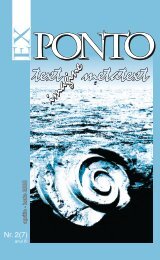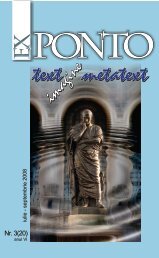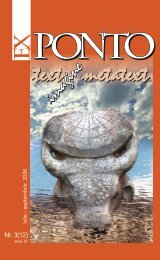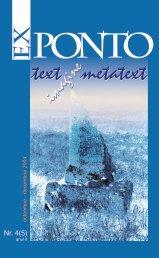Nr. 3 (28) anul VIII / iulie-septembrie 2010 - ROMDIDAC
Nr. 3 (28) anul VIII / iulie-septembrie 2010 - ROMDIDAC
Nr. 3 (28) anul VIII / iulie-septembrie 2010 - ROMDIDAC
Create successful ePaper yourself
Turn your PDF publications into a flip-book with our unique Google optimized e-Paper software.
Ex Ponto nr.3, <strong>2010</strong><br />
postmodern society replaced reality itself with a third-order simulation of<br />
reality, that is, a simulation which precedes its original, and which discards the<br />
real altogether. 14 Many of Murakami’s characters risk losing their very identity<br />
since this identity is artificially constructed on a hyper-reality with no original<br />
ground, but which seems real. This is why it is quite frequent in his novels<br />
that female characters vanish, leaving behind what McHale called “ontological<br />
uncertainty” and the pervasive question: Is this real or is it a dream? These<br />
characters are engorged by the black hole of inexistence, which is not to be<br />
mistaken for death. Existence must be recorded, or else it is dismissed as<br />
a dream, as a phantasm; there must be an element to cling to so as to rest<br />
assured reality is still at reach. Memory needs back-up, it is the only guarantee<br />
for reality; if the pieces of evidence are gone, all that seemed real at a point<br />
in the past becomes part of the imaginary realm. Hence, the sense of illusion,<br />
hollowness, and the division of selves into the two ontological spaces. The split<br />
is sometimes felt; characters often describe a feeling of something breaking<br />
inside them, followed by a shock that leaves behind an emotional desert.<br />
The hero of Norwegian Wood feels the need to write about Naoko so<br />
that she won’t disappear from his mind and thus disappear completely from<br />
existence. Even though she is dead, she exists in his memories, whereas<br />
forgetfulness would really bestow a dreamy, unreal quality upon her. In The<br />
Wind-Up Bird Chronicle, Toru’s wife also disappears, with clear evidence that<br />
she is still alive; yet the instances when he communicates with his wife acquire<br />
a hyper-real dimension; significantly, their most intense dialogue occurs<br />
through a computer, that is, through a simulation of words and face-to face<br />
conversation. Eri Masai, in After Dark, gets transferred to a TV screen and<br />
turned into an image which fades away and threatens to make her captive<br />
in an electronic limbo. South of the Border, West of The Sun is basically, the<br />
story of a chimera; the acknowledgement of this fact leads to something that<br />
Hajime describes as a desert or as rain that is unfelt by the creatures of the<br />
sea: “Inside that darkness, I saw rain falling on the sea. Rain softly falling on<br />
a vast sea, with no one there to see it. The rain strikes the surface of the sea,<br />
yet even the fish don’t know it is raining”. (SBWS:187)<br />
But one of the most conspicuous cases of personality split and trauma is to<br />
be found in one of the female characters of Sputnik Sweetheart, Miu. According<br />
to her confession, she was trapped in a Ferris wheel one night in a Swiss<br />
town and looked through binoculars at her own self standing in an apartment.<br />
She was having sexual intercourse with a Latin type of man, Ferdinando, whom<br />
she had met in town. The experience made her feel debased and obscene,<br />
and, as a result, she lost consciousness. After this odd incident, her hair went<br />
completely white and she became an asexual being, entering a marriage<br />
with the condition of having no sexual relations. 22-year-old Sumire, who is<br />
in love with Miu, describes Miu’s present self as a shadow of her true self.<br />
According to Sumire, Miu’s bodily persona was caught on the other side, yet<br />
she loves both the Miu of the present and the Miu of the other side. A sense<br />
of empathy makes Sumire relate to her beloved’s trauma: “I’m in love with<br />
Miu. With the Miu on this side, needless to say. But I also love the Miu on<br />
the other side just as much. The moment this thought struck me it was like<br />
I could hear myself -with an audible creak—splitting in two. “ 15 What follows<br />
immediately after this awareness of dissociation is an existential question,<br />
one that Murakami’s characters are haunted by: “If this side, where Miu is, is<br />
not the real world - if this side is actually the other side - what about me, the<br />
172
















